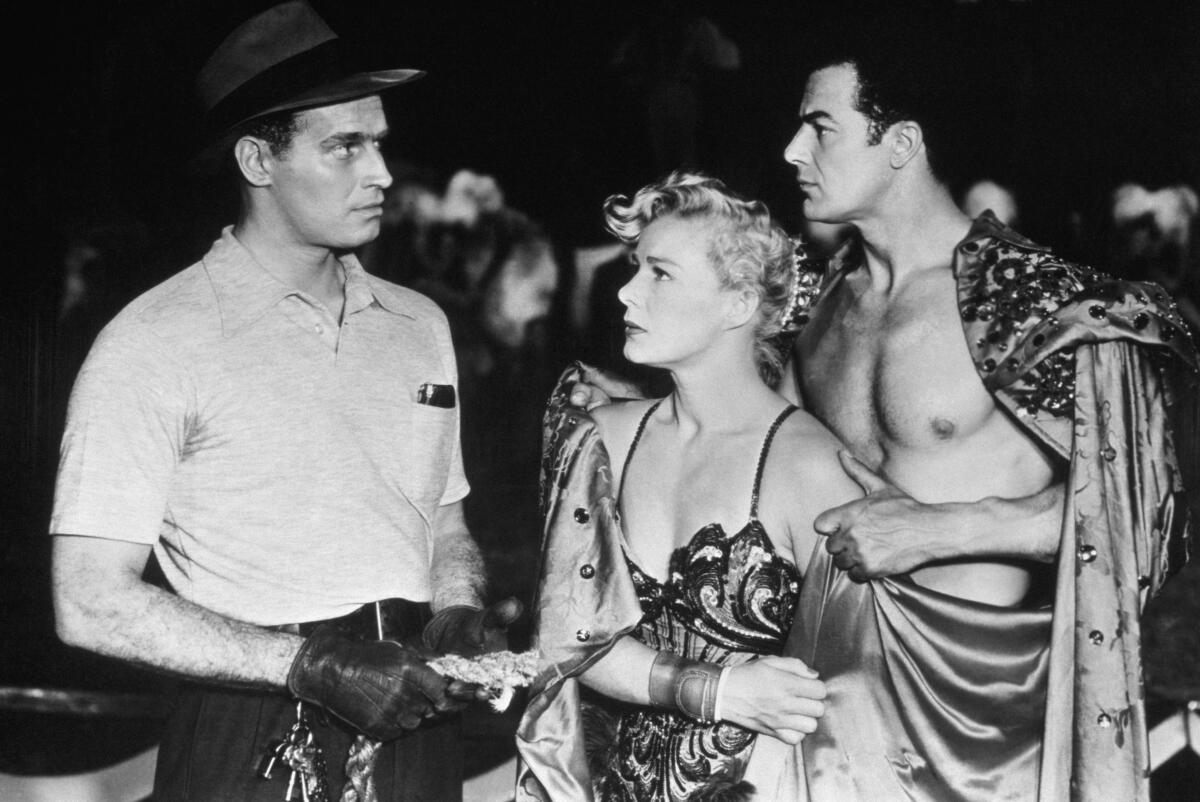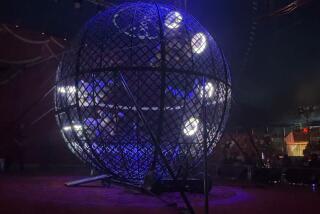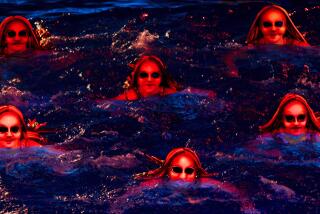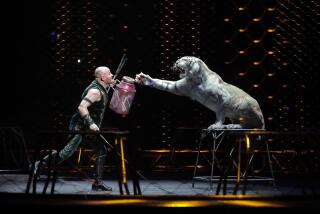From the Archives: ‘Greatest Show’ DeMille triumph

The old trite phrase “with full panoply of glory” may well be applied to the way in which Cecil B. DeMille brings the circus to the screen in “The Greatest Show on Earth,” a picture to be reckoned as one of the greatest of this master showman’s shows.
It opened yesterday at the Orpheum and Warner’s Beverly Theatres, where it is undoubtedly due to have a long run.
DeMille provides the maximum of entertainment in his production, not to speak of glamour, and above all the spirit that forever lurks under the big top.
Even DeMille dissenters — and there are always bound to be a number among the supercritical — will unquestionably be fascinated by this example or his peculiar picture-making genius. He has all the latitude necessary in the subject itself for gorgeous and tinseled display. He succeeds by the very nature of things in giving what happens great authenticity. Moreover he tells a human narrative that has both appealing and thrilling climaxes.
DeMille Narrator
DeMille himself is the narrator of the picture behind the scenes. His booming voice launches the film on the way with a vivid word impression of what the circus means.
He is heard now and again punching over the bigger panorama of the story, so picturesquely shown on the screen with all the facilities made available by the Ringling Bros. and Barnum & Bailey Circus.
Starting in Florida winter quarters to introduce preparations for the season, and with the various characters appearing, “The Greatest Show on Earth” becomes in the big DeMille way not only a colorful story of various central characters, but above all a saga of the whole troupe and the crowd.
Reactions of the public are wonderfully balanced against the performances in the circus rings. There is movement, life and action, both intimate and vast, throughout the film, right up to the final climax of the sensational railroad wreck.
Shining lustrously in the action is Betty Hutton as a trapeze artist, who finds herself in competition with Cornel Wilde in his spectacular role as a performer of the same type. Coolly devoted to Betty and ever authoritative in the circus is Charlton Heston, whose stock soars more than measurably because of his portrayal.
Hidden as Clown
James Stewart is concealed behind clown makeup but conveys a peculiarly sensitive interpretation of a fugitive. Both Dorothy Lamour and Gloria Grahame sparkle in the other feminine assignments.
They make up a truly stellar cast, supported by Henry Wilcoxon, Lyle Bettger, Lawrence Tierney, Emmett Kelly, Cucciola, and Antoinette Concello. The aggregation beyond that is tremendous.
The picture will probably most benefit Miss Hutton and Heston, since it is a new revelation of their talents, but it will also definitely add to the stature of Wilde.
Miss Hutton will he a bidder for Academy honors for the new year, because of her radiant charm in her role and the fact that she is capable of so many rare shades of emotion. DeMille has brought out her super best.
It apparently took an array of writers to supply the script, for story credits are bestowed on Fredric M. Frank, Theodore St. John and Frank Cavett, while the screen play was written by Frank, Barré Lyndon and St. John.
No matter how many the writers, DeMille has welded their efforts into a single well-organized tremendous unit.
“The Greatest Show on Earth” is one of the finest pictures.
Victor Young wrote the score and a battery of noted cameramen shot the film.
More to Read
Only good movies
Get the Indie Focus newsletter, Mark Olsen's weekly guide to the world of cinema.
You may occasionally receive promotional content from the Los Angeles Times.










